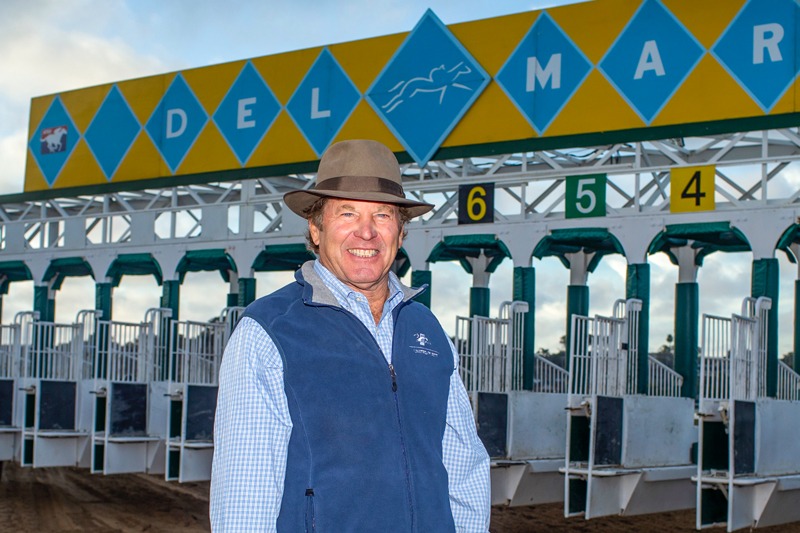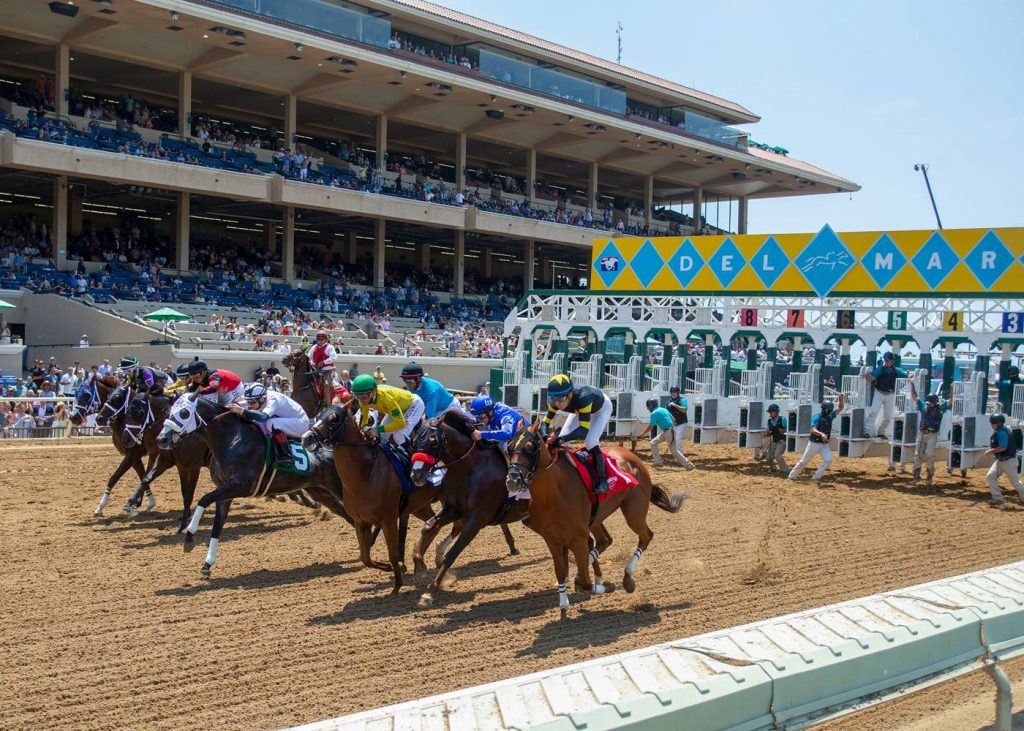
Jay Slender (Benoit Photo)
By Jim Charvat
Who, as a kid, didn’t line up 2-or-3 friends on the school playground and shout “On your mark, get set, GO !!!” … and then watch the runners pitter patter some 10-to-20 yards, through a mass of children, to an imaginary finish line
Well, in not so many words, that’s what Jay Slender does for a living, except he’s dealing with anywhere from four to 14 high-strung Thoroughbreds locked in a metal gate in a space just big enough for them to fit and stand up straight.
Jay Slender is the official starter at Del Mar. Eight or nine times every day this fall, he’s in charge of giving the horses a fair start to the race. And that’s putting it simply. He’s also responsible for the safety of each horse, jockey and assistant starter. You don’t hear Trevor Denman’s “And away they go” or Larry Collmus’ “And they’re off” until Jay Slender says so.
Slender’s day begins first thing in the morning. He oversees schooling at the gate during training hours from 6:30 to 9:30.
“The bad horses are the ones you learn about,” Slender says. “If a horse acts up in the afternoon, I have a thing called ‘the starters’ list.’ It goes to the racing office and if your horse is on that list, they can’t run again until they come back and school in the morning. Most trainers have enough sense to spend some time at the gate and get their horses to relax but there are others who are a little more hardheaded. It’s all about making it safer for the jockeys and the horse.”
And he’s busy. On average, in the summer, they get up to 50 horses working out of the gate in the morning. But despite Jay and his crew’s best efforts, there’s always that one horse that will not go in, and if he has to, Slender will scratch a misbehaving horse before the race.
“It’s not fair to everyone else,” he explains. “I try to give my guys enough time to try everything. Open the front doors, lock arms and push him in. We had a horse here recently we had five guys on her. That horse’s behind was off the ground but she was like a mule, her front legs were locked and set in the dirt. She was the favorite so I didn’t want to scratch her. It got close but they finally got her in, and she didn’t run anywhere.
“If the trainers school them (the horses) then it pays off in the gate,” Slender says. “Then the horse just stands and is relaxed and saves all their energy for the race. Horses are like people, they’re all different. Some are levelheaded, some act-up. We just try to get along with them.”
After schooling, Slender gets a break until the first race of the day, at 2 p.m. during the summer meet, 12:30 in the fall. He says he might get some additional work done or he might go surfing.
“I love to surf but I haven’t figured out how to make any money at that beach,” Slender jokes. “When the races are over I leave, I get away from the track. Try to keep my head clear.”
Part of Slender’s daily preparation involves the track program, in which he goes through each race and puts together an assignment sheet for his gate crew.
“You have one (assistant starter) per horse,” Slender explains. “I have a guy out in front in case we have one that won’t load, he’ll crack the front door. Some get spooked and if they see that opening hopefully they’ll walk in. Then there’s horses that don’t want any part of it and we have a couple of extra guys that lock arms and literally pick him up and push him in sometimes.”
Before each race, before the horses have arrived at the gate, Slender will refer to his program and bark out, “Carl the one. Kelly two, Keel three, Jesse four, John Boy five, Eddie six,” assigning an assistant starter to each horse. Dressed in their teal green Del Mar shirts and their black protective vests, the crew waits at the gate as each horse approaches from the post parade and then walks their horse into the gate.
“It’s kind of like a puzzle,” Slender says. “Certain guys might be a little stronger. If there’s a horse that’s bad, you’re not going to put your weakest link with that horse. Like any job, you have guys you’re a little more confident with than others.”

Once inside the gate, the assistant starter will stand on a thin metal ledge built into the side of every stall. Once perched on the ledge, which is just a few inches wide, they’ll hang onto a handle on the side of stall with their left hand and grab the not-always-obedient, thousand-pound animal with their right hand and wait until the gates open.
“There’s not much room in that gate for them and the horse,” Slender points out. “When they first proposed helmets, we were against it but it’s paid off. You get caught upside the head or you can get kicked in the vest.”
Yet as dangerous as the job is, members of Slender’s gate crew have been with him since his first starting job at Los Alamitos in 1991.
“This is like my second family,” Slender says. “Everyone has each other’s back. If something happens in that gate, these guys are bullfighters, they forget about safety. They dive in there and pull a guy out or a jockey or a horse. You put your body on the line a lot of times.
“The crew makes the starter,” Slender admits. “If you don’t have a good crew, you got nothing. The other day a guy got a paw (hoof) in his leg and he was limping around afterward. Any other job that guy would still be on disability but he was back for the next race.”
While the horses are entering the gate, Slender is standing a couple yards in front, along the rail, watching and observing as they load. What is Jay Slender looking for before he presses the starter button?
“Mainly it’s their heads you’re watching,” he says, “and their hooves. Some are dancing a little bit, they’re a little nervous. The key is to keep the horses relaxed until the last horse loads. When that last one is coming in, you’re looking to make sure they’re all looking ahead, down the track.”
“These horses have a short fuse,” Slender continues. “I try not to keep them in there too long so I’m watching for movement, it’s all about the movement.”
On occasion, an assistant starter might call out, “no, no, no, no, no” in a quick staccato call, telling Slender to wait. The jockeys are also a part of the process.
“The jocks will let out (yell) if they’re not right,” Slender says. “They can feel the horses moving around,”
Once everything meets Slender’s criteria and he’s satisfied with the horses positioning, he presses a device that resembles a pistol grip. It cuts off the flow of electricity to magnets in the doors of the gate. These magnets keep the doors closed. Once they’re demagnetized, the doors fly open.
“Every race is a rush, that’s what’s neat about this job,” Slender says. “You can have a great start but you better be ready for that next race. You gotta be kind of fired up during the day, kind of coffee’d up because it’s all about your concentration and reflexes, and listening to everybody. You have to learn to take the pressure and then face these trainers when not everything goes right.”
So how does someone become a starter at a major racetrack like Del Mar? It’s certainly not something you go to school to learn and there are not many jobs like it. In Slender’s case, he followed in his father’s footsteps.
“My grandparents were both trainers up at the fairs,” Slender says. “My dad worked on the gate as one of the assistant starters. So every summer while I was growing up in Arcadia, school would get out and we would load the trailer and we’d go from track to track on the fair circuit. I was young. From six-years-old until about 10 I would just hang out at the gate all day long. Back then you could ride the gate around so I would jump on the gate when they pulled it around.”
“When I got a little older,” Slender continues, “my dad got the starter job at Santa Anita and a couple of other tracks. I started doing the rake, you see the guys raking the tracks. I was 14 or 15 years old, I was behind the gate before a race one day and my dad yelled, ‘Jump up in there with number five.’ So I jumped up in there. There was this female jock, Cheryl White, and she said to my dad, ‘Tuck, you’re going to get him killed.’
Forty seven years later, Slender is doing just fine, though he had his share of injuries working the gate all those years.
“A horse was acting up and whipped its head and hit me in the temple,” Slender says. “I was out but I still had the rein in my hand. I just remember seeing the fourth of July stars. I’ve had broken lips and ankles and knees.
“There was one time I was underneath a horse looking up at its belly,” Slender continues, “and as he reared-up I crawled underneath the front doors to get away. I didn’t have enough sense to keep running, I jumped back in there.”
By the time Slender got to high school he was ready for something different, something outside of horse racing.
“We had horses at our house in Arcadia and I had to clean their stalls every morning and every night,” Slender says, “so I was getting sick of horses. I was playing ball and messing around and when I got out of high school I went to college.
“I was at Pasadena City College for about six months,” Slender notes, “and my grades weren’t the best. My dad was the starter at Los Alamitos and guys got hurt and they were shorthanded so he told me get my butt to Los Al and I’ve been working at the track ever since.”
That was 1978. He worked in the gate until 1991 when he was offered the job as starter at Los Al.
“My dad had left Los Al to work at Santa Anita,” Slender remembers. “They went through a couple of starters at Los Al and an opening came up and Doc Allred gave me my first shot.”
Six years later he landed the job at Santa Anita and in 2015 he brought his talents to Del Mar. Now 62-years-old, Slender has been married to Patti for 29 years and they have two daughters, 26 and 22, both in college. He calls Huntington Beach home.
“I stay down here during the Del Mar meet,” Slender says. “Some nights I’ll drive home but that drive is getting hard. So I stay with my in-laws who live down here and I’ll camp out in my trailer.”
Despite the inconveniences and days away from home, Slender loves his job and his dedication has paid off. He has worked some of horse racing’s biggest days, from the Breeders’ Cup to the TVG Pacific Classic to the ‘Big Cap’.
“I’ve worked eight or nine Breeders’ Cups including the very first at Hollywood Park,” remarks Slender. “You try to keep it all the same every race, from an $8,000 claimer to a $6 million race. That’s not to say your heart might not race a little faster before the Breeders’ Cup Classic.”



